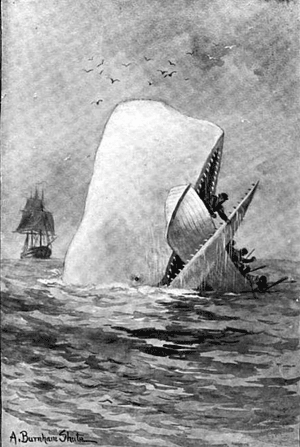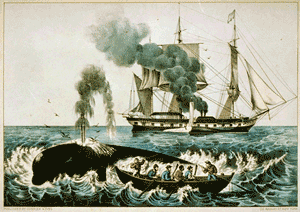Whaling History

Image from Moby Dick
Humans likely first took advantage of stranded whales that washed up on shore for many products. As humans became better at using weapons and travelling in boats, they likely took advantage of killing whales that travelled close to shore.
Whales have been hunted for many products including meat, bones, blubber (oil), and the "whalebone"(baleen). Whale oil obtained from sperm whales (Physeter macrocephalus) right whales (Eubalaena japonica, E. glacialis, and E. australis), and bowhead whales (Balaena mysicetus) was in high demand. The oil in the head of sperm whales, called spermaceti, is solid when cold and was one of the most sought-after oils because it burned without smoking and was used for lamp oil and candle making . It was also used as a lubricant in machinery and for margarine. A single large sperm whale could yield as much as three tons of sperm oil.
The hard structures of whales have many purposes. Whale bone or baleen is hard and durable like bone, but also has some flexibility. In the past, it was used in many every-day items including children's toy, buggy parts, and corsets. Whale teeth were carved or engraved used for art, chess pieces, and piano keys.

New England whaler by Currier & Ives
Another product created by some whales is ambergris. The stomach of sperm whales secrete this greasy substance. Some researchers suggest that it is used to help protect the digestive tract from hard or sharp pieces of food that the whale might eat (like squid beaks). Clumps of this material can be found floating on the ocean surface, or washed up on beaches. As ambergris dries its odor changes to a more "earthy" smell. It was historically collected for use as a medicine, but was later used by the perfume industry.
Historically, native or aboriginal peoples living close to the ocean have also hunted whales and collected materials from stranded whales for multiple uses. Meat and blubber were taken for food. Ribs from the larger species of whales were used as construction materials for huts. Other bone was used for art, tools, and utensils. Whale and other marine mammal blubber was processed into oil which was used for lamps. Any unused parts were used as a fertilizer for fields and plants. Native peoples still harvest a limited number of whales every year for their subsistence.

Processing whale blubber on the deck of a ship
Whaling in North America has been documented as early as 1614. Colonists in the New World were documented hunting whales from the shore of Nantucket and current day northeastern United States. People were stationed on shore from a tall post (or from the mast of a ship on or near shore) to spot whales. Once a whale was discovered, it was captured and brought back to shore for processing. By the mid- to late-1700's whaling ships were provisioned for long voyages in search of whales. In the 1700's-1800's the whaling industry was at its peak. In 1837 the state of Massachusetts listed over two million dollars of capital from the sale of whale oil. In 1840, the United States documented 4.75 million gallons of sperm whale oil, 7.5 million gallons of oil from other whales and fish and just over 1 million dollars worth of whale bone and other items obtained from whales. From 1775 to 1846, the number of whaling vessels sailing from North America increased from 300 to 730.
By 1872, the whaling industry in North America was already on the decline, down to 218 vessels, because of the declining numbers of whales. From 1835 to 1872, the American whaling industry was estimated to have captured or destroyed 292,714 whales. If people from other countries hunted whales as a similar rate, the rapid decline of most of the more valuable species of whales (sperm whales, right whales, and bowhead whales) is not surprising.
Modern whaling is conducted primarily for meat. The use of whale oil declined in the mid-1800's as kerosene and other petroleum products started replacing its use and as population levels of the great whales declined.
References:
Oberthür, S. The International Convention for the Regulation of Whaling: From Over-Exploitation to Total Prohibition. Yearbook of International Co-operation on Environment and Development (YBICED) 1998/1999. Pg 29-38.
The International Whaling Commission. 2011. ASW Catches. Retrieved 15 December 2011. http://www.iwcoffice.org/conservation/table_aboriginal.htm.
The International Whaling Commission. 2011. Catches Under Objection. Retrieved 15 December 2011. http://www.iwcoffice.org/conservation/table_objection.htm.

 Marine Mammals of Georgia
Marine Mammals of Georgia